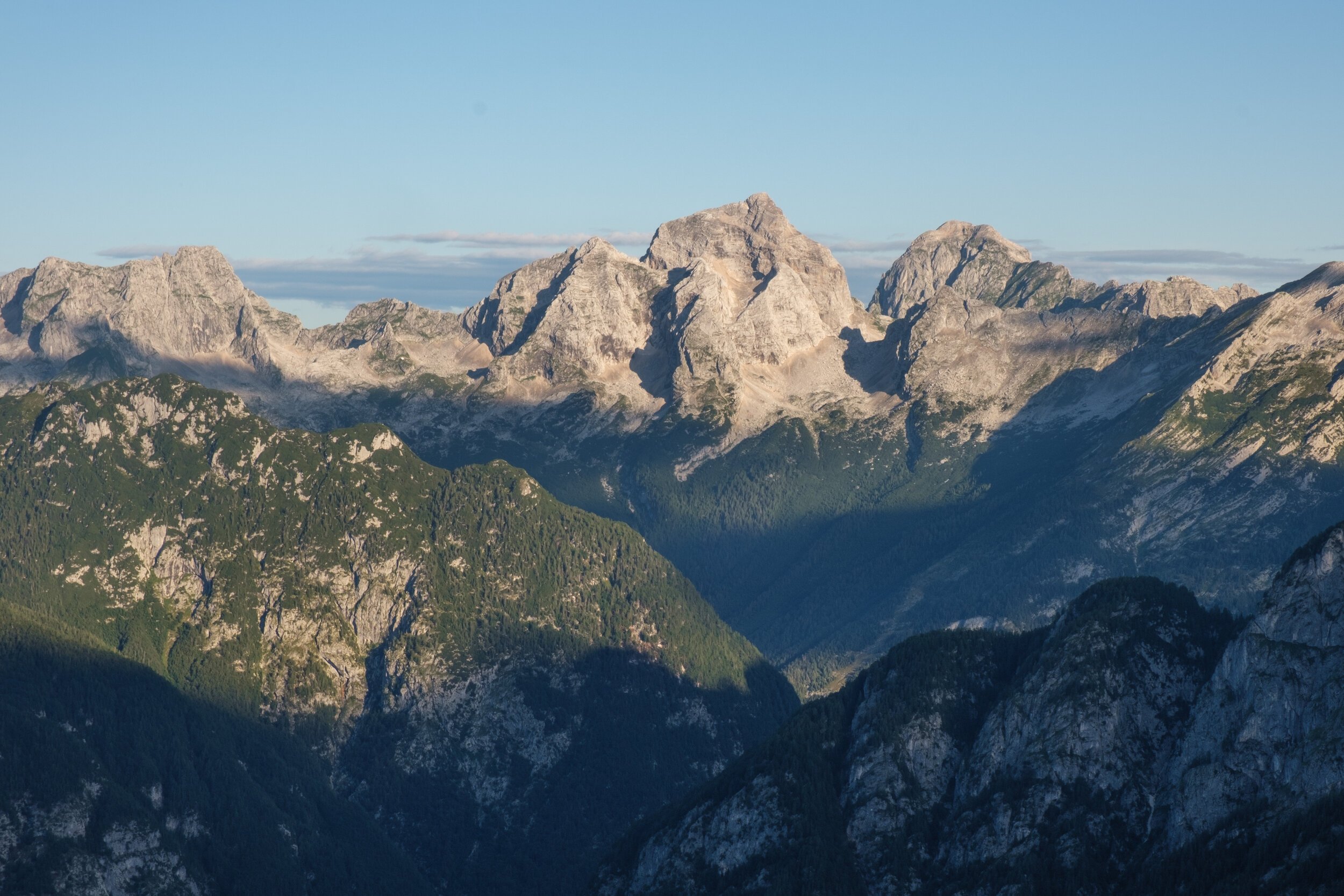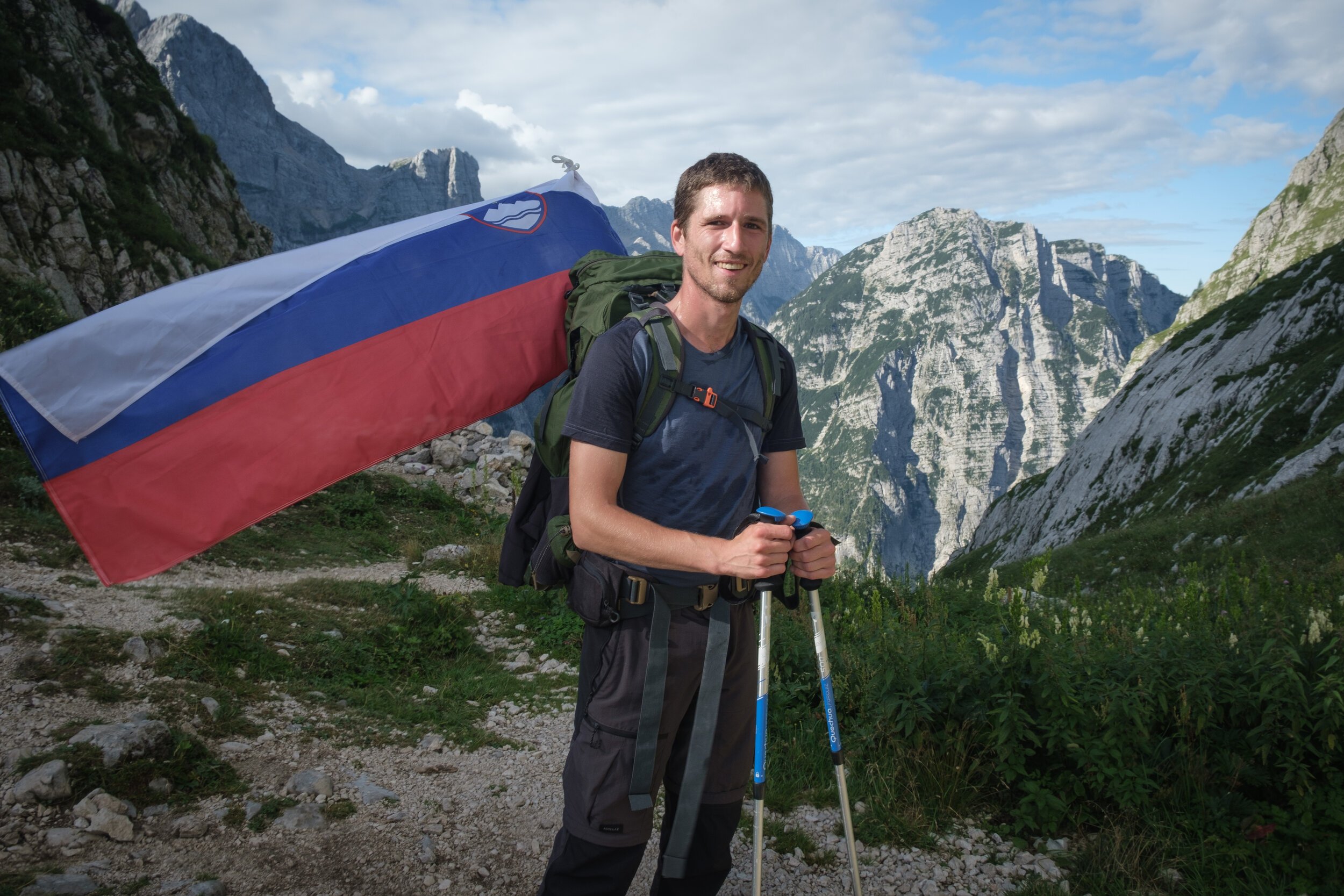The Slovenian Mountain Trail
The Slovenian Mountain Trail is a long-distance hiking route across Slovenia from Maribor to the Adriatic Sea. It traverses some of the most stunning landscapes of one of the most beautiful countries in Europe, Slovenia. It is billed as the oldest long-distance trail of its kind, started by the Slovenian Alpine Association in 1953. Since then, other long-distance trails through the Alps may have surpassed it in popularity, but within Slovenia it remains the most popular long-distance trail, and for good reason.
The Julian Alps
Hikers generally don’t carry camping gear and stay each night in one of the many mountain refuges scattered around the country. In fact it’s forbidden to wild-camp in Slovenia. The refuges vary quite a bit in their amenities, but you can always count on basic shelter and a hot meal. Slovenian mountain fare is extremely tasty and filling. A bean or barley stew, with sausage or not for the vegetarians, bread, and perhaps a beer or schnapps and hot tea, quickly becomes a ritual way to end the day. Food for lunch is best carried if you plan to cover longer daily distances, since a stop-off at a hut can become a drawn-out affair, and there are grocery re-supply options in the quaint mountain towns that you’ll pass through every few days as you traverse the ranges and valleys.
Animal encounters are common in the Kamnik-Savinja and Julian Alps. I’m partial to the cheeky ibexes, perhaps a bit too fearless of humans and their Toblerone scented packs, but charming and more than a little magical. Chamois are present too, skillfully navigating the scree and boulders.
Here you can see a trail descending from Koča na Doliču hut. It was blasted out of the rock face by the Italian Army during the interwar period - one of the many facts gleaned from reading the official Slovenian Mountain Trial guidebook, an indispensable reference for planning and undertaking this hike, and available in English and Slovenian at bookstores in Ljubljana and Maribor.
I met this local somewhere in the Julian Alps. He was near the half-way point of his trip, proudly displaying his Slovenian flag. In Slovenian they call the route Transverzala, which just means ‘long-distance trail’. That’s how central a place it occupies in the minds of Slovenian nature lovers. In fact, just about everyone in Slovenia seemed to relish hiking and/or mountaineering. Many times I saw young children scrambling up rocky routes that would have sent many generally fit adults from other countries back down the trail from whence they came. Families, retirees, young couples, groups of friends - they all seemed to take equal pleasure in a good nature-soak, and were fearless on the high mountain trails of their homeland.
The Triglav Lakes are a particularly welcoming sight on a July or August afternoon, though according to the national park rules and culture you’re not supposed to swim in them, to preserve their pristine state. That’s a bit much to ask from a sweaty, jolly group of German hikers though, who gleefully went skinny dipping, only to be given a severe scolding by some local hikers.
The route has a distinct fairytale vibe, with views that are all the more majestic having been well-earned. The official route has you summiting not just Triglav, Slovenia’s highest peak, but other stonkers like Jalovec, Stol, Razor and Krn.
One of the highlights for me was getting a taste of mountaineering without the need for complicated equipment and ropes, or any kind of training, just some basic good sense, level-headedness and sure-footedness. The trail is very well marked, and emergency rescue situations generally occur when climbers lose sight of the trail marker and forge ahead instead of backtracking to the last known marker. A helmet is required in the more technical sections of Triglav National Park and a few other places due to the very real risk of loose rock falling from above. But otherwise the via ferrata sections, the system of iron pegs and steel cables bolted into the mountain to make it navigable to the general public, are remarkably well designed and marked.
It’s best to make reservations in advance at the shelters, but realistically speaking for those doing the whole trail, days will almost inevitably be shifted due to energy levels, weather, and other factors. The refuges are required to provide shelter if you arrive within a couple hours of nightfall - they’re not going to toss you out to survive the harsh alpine night, but you might end up sleeping in an entryway or dining room. That said, I didn’t have a problem getting a single or shared room every night, even when I turned up without a reservation.
Being a member of one of the European Alpine Associations will get you a hefty discount on accommodation at the shelters. It was easy to join the Slovenian Alpine Association, even as a foreigner without residence in Slovenia.
I’ve hiked about two-thirds of the trail so far, splitting it into three 7-10 day trips. Perhaps I’ll do the whole thing in one go someday, which according to the official guidebook is 617.4 km long, and should take around a month of pretty intense hiking to complete. Many people compete for the speed record, currently standing at 7 days, 8 hours, and 10 minutes. I’d suggest taking in its magnificence at a somewhat more leisurely pace. To be listed as an official finisher, you’ll have to get the official passport booklet, available at tourist kiosks in Maribor and Ljubljana, and stamp various summits and checkpoints along the way - bring your own ink.
For those simply wanting to soak in this breathtaking, lesser known corner of the Alps, a few days or more on the trail guarantee an unforgettable natural and cultural experience.









